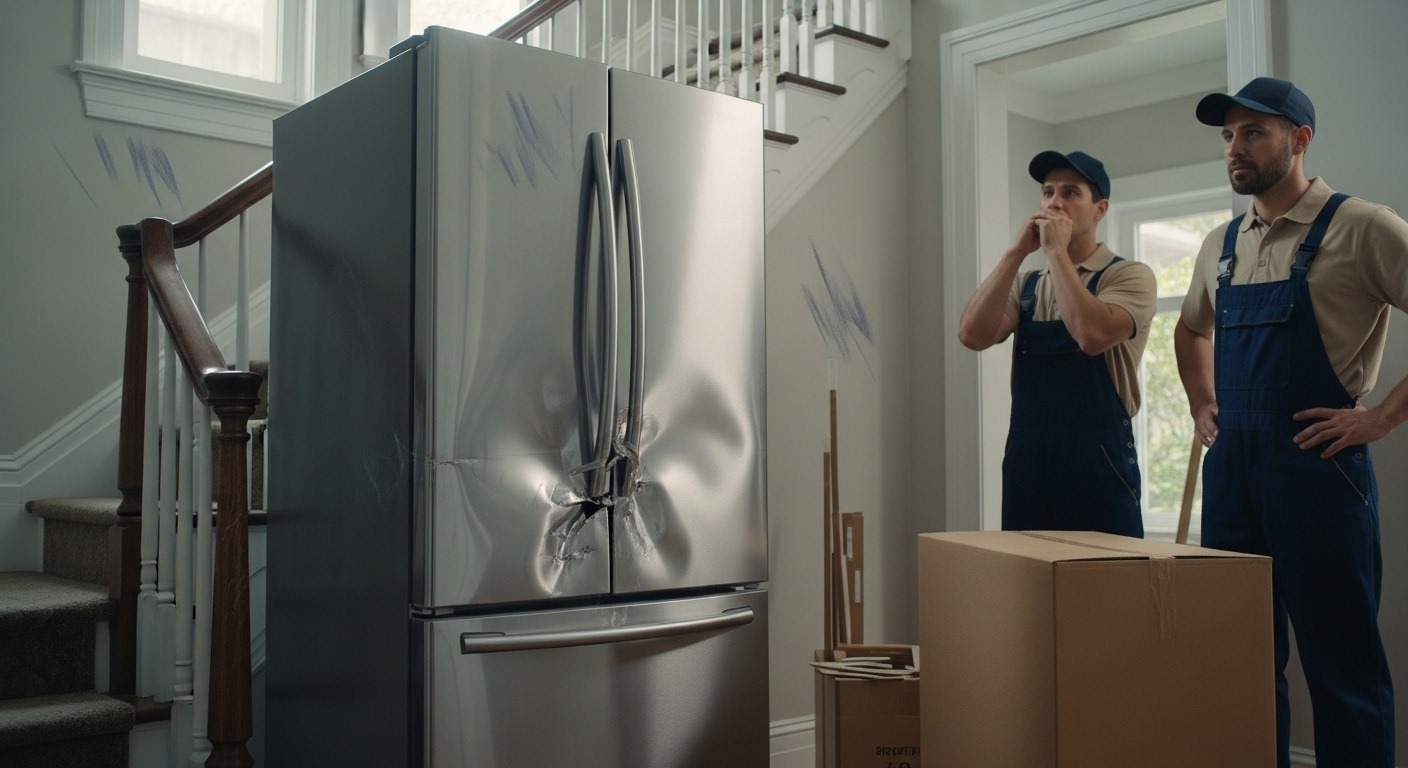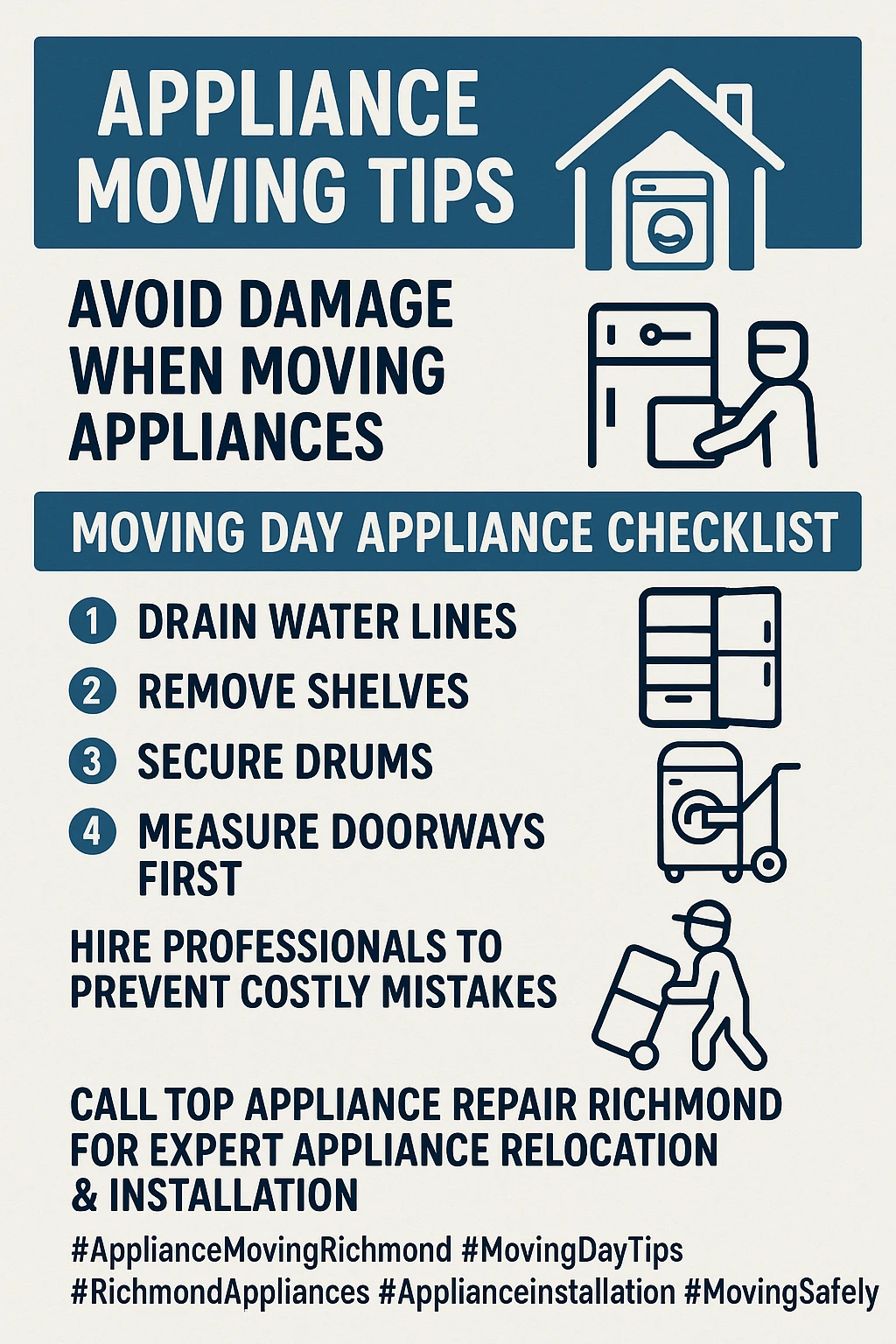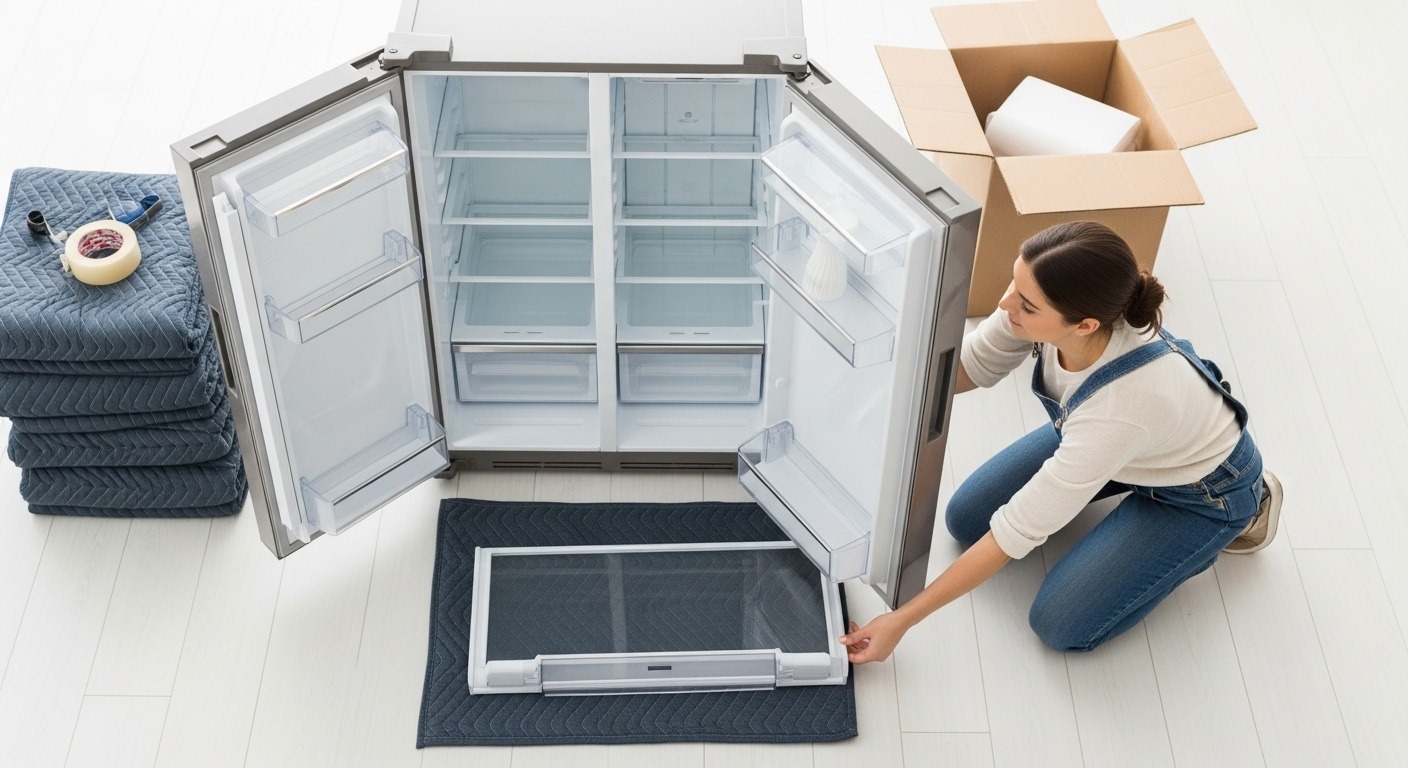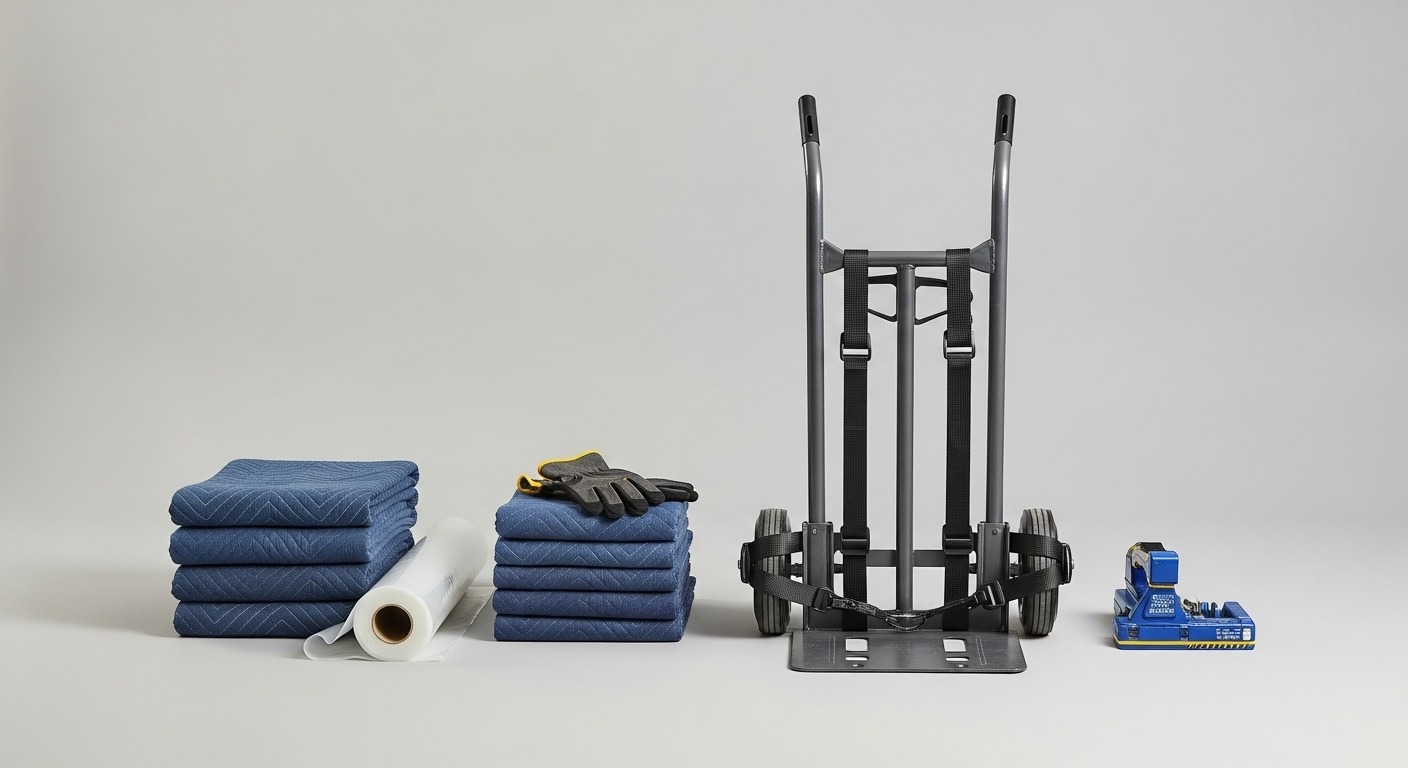Moving Day Appliance Disasters: How to Safely Relocate Your Richmond Home’s Major Appliances Without Costly Damage
Worried about turning your Richmond home move into an expensive appliance nightmare? Moving major appliances without proper preparation can cost homeowners between $150 to $600 per damaged unit, but with the right techniques and planning, you can relocate everything safely without breaking the bank or your back.Picture this: you’re finally moving into your dream Richmond home, everything’s going smoothly until you hear that gut-wrenching crash from the kitchen. Your brand-new stainless steel refrigerator just took a tumble down the stairs, leaving you with a $400 repair bill and a moving day from hell.  Unfortunately, this scenario plays out in countless Richmond homes every year, turning what should be exciting milestones into expensive disasters.The reality is that professional appliance moving services in Richmond charge between $120 to $180 per hour for a reason – these machines are heavy, delicate, and require specialized knowledge to relocate safely. From refrigerators that need 24-48 hours of preparation before moving to gas stoves that require professional disconnection, each appliance comes with its own set of challenges that can quickly overwhelm unprepared homeowners.Richmond’s unique housing landscape adds another layer of complexity to appliance moves. Many older homes in the area feature narrow hallways, steep staircases, and doorway dimensions that barely accommodate modern appliance sizes. Combined with the Pacific Northwest’s notorious wet weather that can complicate outdoor transport, Richmond residents face specific challenges that require careful planning and execution to overcome successfully.
Unfortunately, this scenario plays out in countless Richmond homes every year, turning what should be exciting milestones into expensive disasters.The reality is that professional appliance moving services in Richmond charge between $120 to $180 per hour for a reason – these machines are heavy, delicate, and require specialized knowledge to relocate safely. From refrigerators that need 24-48 hours of preparation before moving to gas stoves that require professional disconnection, each appliance comes with its own set of challenges that can quickly overwhelm unprepared homeowners.Richmond’s unique housing landscape adds another layer of complexity to appliance moves. Many older homes in the area feature narrow hallways, steep staircases, and doorway dimensions that barely accommodate modern appliance sizes. Combined with the Pacific Northwest’s notorious wet weather that can complicate outdoor transport, Richmond residents face specific challenges that require careful planning and execution to overcome successfully.
Key Outtakes:
- Refrigerators require 24-48 hours of preparation including complete defrosting before moving day to prevent costly water damage
- Professional appliance moving services cost $120-180 per hour but prevent repair bills averaging $150-600 per damaged appliance
- Gas appliances require professional disconnection and reconnection to ensure safety and building code compliance in Richmond
- Proper equipment including appliance dollies, moving blankets, and surface protection materials is essential for preventing damage to both appliances and homes
- Richmond’s older housing stock and wet climate create unique challenges requiring specialized techniques and timing considerations

Understanding the Risks: Why Appliance Moving Goes Wrong
The seemingly simple task of moving appliances from one location to another conceals numerous potential disaster scenarios that can cost Richmond homeowners hundreds or even thousands of dollars. Most appliance moving catastrophes stem from a fundamental misunderstanding of the preparation requirements and technical complexity involved in safely relocating these sophisticated machines. Unlike furniture or boxes, major appliances contain delicate internal mechanisms, fluid systems, and electronic components that can suffer irreversible damage from improper handling.Water damage represents one of the most common and expensive consequences of improper appliance preparation. Refrigerators and freezers that haven’t been properly defrosted can leak gallons of water during transport, damaging hardwood floors, carpeting, and other belongings in the process. The defrosting process requires a minimum of 24 hours to complete properly, yet many homeowners attempt to shortcut this timeline, resulting in water damage that far exceeds the original appliance value.Internal component damage occurs frequently when appliances are moved without proper preparation or securing techniques. Washing machine drums that aren’t stabilized with shipping bolts can suffer permanent damage from movement during transport, while refrigerator shelves and drawers that aren’t removed can become projectiles that crack internal walls or damage cooling coils. These internal damages often aren’t immediately apparent but manifest as operational problems weeks or months after the move, when warranty coverage may no longer apply.Physical damage to appliances and property represents another major category of moving disasters that plague Richmond homeowners. Scratched hardwood floors, dented appliances, damaged doorframes, and gouged walls commonly result from attempting to move heavy appliances without proper equipment or technique. The weight of major appliances, ranging from 200 to 400 pounds, requires specialized moving equipment and multiple people to handle safely, yet many homeowners underestimate these requirements until damage has already occurred.
Pre-Move Preparation: The Foundation of Success
 Successful appliance relocation begins with comprehensive preparation that must start days before the actual moving date arrives. This preparation phase represents the most critical component of the entire process, as shortcuts taken during preparation almost inevitably result in problems during the actual move. Understanding the specific requirements for each appliance type and allowing adequate time for proper preparation can mean the difference between a smooth relocation and a costly disaster.The timeline for appliance preparation varies significantly depending on the type of appliance being moved. Refrigerators and freezers require the longest preparation period, with complete defrosting needing to begin at least 24-48 hours before moving day. This extended timeline allows ice buildup to melt completely and prevents the water spillage that commonly damages other belongings during transport. The defrosting process cannot be rushed through artificial means without risking damage to the appliance’s cooling system or creating excessive moisture that complicates the moving process.Cleaning procedures for each appliance type require specific attention to detail that goes beyond surface cleaning. Stoves need thorough degreasing of burners, drip pans, and interior surfaces, while dishwashers should undergo a final cleaning cycle with hot water and detergent to remove food residue and detergent buildup. Washing machines require draining of all water from hoses, pumps, and drums to prevent water damage during transport.Component removal and separate packaging represent essential steps that many homeowners overlook during preparation. Refrigerator shelves, drawers, and removable bins must be taken out and packed separately to prevent them from becoming projectiles during transport. Stove grates, drip pans, and oven racks require careful removal and individual wrapping to prevent scratches and facilitate easier reassembly at the destination. Each removed component should be clearly labeled and photographed before removal to ensure proper reinstallation.Measurement and route planning form another crucial aspect of preparation that prevents costly delays and damage on moving day. Every appliance’s dimensions must be carefully measured and compared with doorways, hallways, staircases, and any tight corners along the planned route. Some Richmond homes may require removing doors from hinges or utilizing alternative entrances like sliding glass doors to accommodate large appliances, planning that must be completed well before moving day arrives.Documentation and photography of existing connections provide valuable reference materials for reinstallation at the new location. Taking detailed photos of gas connections, electrical hookups, water line attachments, and positioning before disconnection creates a visual guide that simplifies reconnection procedures. This documentation proves particularly valuable for complex appliances like dishwashers that may have multiple connection types and specific installation requirements.
Successful appliance relocation begins with comprehensive preparation that must start days before the actual moving date arrives. This preparation phase represents the most critical component of the entire process, as shortcuts taken during preparation almost inevitably result in problems during the actual move. Understanding the specific requirements for each appliance type and allowing adequate time for proper preparation can mean the difference between a smooth relocation and a costly disaster.The timeline for appliance preparation varies significantly depending on the type of appliance being moved. Refrigerators and freezers require the longest preparation period, with complete defrosting needing to begin at least 24-48 hours before moving day. This extended timeline allows ice buildup to melt completely and prevents the water spillage that commonly damages other belongings during transport. The defrosting process cannot be rushed through artificial means without risking damage to the appliance’s cooling system or creating excessive moisture that complicates the moving process.Cleaning procedures for each appliance type require specific attention to detail that goes beyond surface cleaning. Stoves need thorough degreasing of burners, drip pans, and interior surfaces, while dishwashers should undergo a final cleaning cycle with hot water and detergent to remove food residue and detergent buildup. Washing machines require draining of all water from hoses, pumps, and drums to prevent water damage during transport.Component removal and separate packaging represent essential steps that many homeowners overlook during preparation. Refrigerator shelves, drawers, and removable bins must be taken out and packed separately to prevent them from becoming projectiles during transport. Stove grates, drip pans, and oven racks require careful removal and individual wrapping to prevent scratches and facilitate easier reassembly at the destination. Each removed component should be clearly labeled and photographed before removal to ensure proper reinstallation.Measurement and route planning form another crucial aspect of preparation that prevents costly delays and damage on moving day. Every appliance’s dimensions must be carefully measured and compared with doorways, hallways, staircases, and any tight corners along the planned route. Some Richmond homes may require removing doors from hinges or utilizing alternative entrances like sliding glass doors to accommodate large appliances, planning that must be completed well before moving day arrives.Documentation and photography of existing connections provide valuable reference materials for reinstallation at the new location. Taking detailed photos of gas connections, electrical hookups, water line attachments, and positioning before disconnection creates a visual guide that simplifies reconnection procedures. This documentation proves particularly valuable for complex appliances like dishwashers that may have multiple connection types and specific installation requirements.
Essential Equipment and Tools for Safe Appliance Transport
 The difference between successful appliance relocation and costly disaster often comes down to having the right equipment for the job. Professional-grade moving equipment designed specifically for appliance transport provides the safety, control, and protection necessary to move heavy appliances without damage to the units themselves or the surrounding property. Understanding what equipment is truly necessary versus what might be improvised helps Richmond homeowners make informed decisions about their moving approach.Appliance dollies represent the most essential piece of equipment for safe appliance transport, providing the mechanical advantage necessary to move appliances weighing 200-400 pounds with minimal physical strain. Heavy-duty appliance dollies with proper strapping systems offer superior stability and weight distribution compared to standard furniture dollies or hand trucks. These specialized dollies feature wider bases, higher weight ratings, and securing mechanisms specifically designed for appliance transport.Moving blankets and protective padding serve multiple purposes in appliance transport beyond simple scratch prevention. Professional-grade moving blankets provide cushioning against impacts, protect appliance finishes from scratches, and help maintain appliance stability during transport. The thickness and quality of moving blankets directly impacts their protective capability, with professional-grade blankets offering superior protection compared to lightweight alternatives that may compress under load or tear during handling.Surface protection materials prevent costly damage to flooring, walls, and doorframes during appliance transport through Richmond homes. Professional-grade surface protection films like Builder Board or Neo Shield provide superior protection from scratches and impacts compared to improvised solutions like
The difference between successful appliance relocation and costly disaster often comes down to having the right equipment for the job. Professional-grade moving equipment designed specifically for appliance transport provides the safety, control, and protection necessary to move heavy appliances without damage to the units themselves or the surrounding property. Understanding what equipment is truly necessary versus what might be improvised helps Richmond homeowners make informed decisions about their moving approach.Appliance dollies represent the most essential piece of equipment for safe appliance transport, providing the mechanical advantage necessary to move appliances weighing 200-400 pounds with minimal physical strain. Heavy-duty appliance dollies with proper strapping systems offer superior stability and weight distribution compared to standard furniture dollies or hand trucks. These specialized dollies feature wider bases, higher weight ratings, and securing mechanisms specifically designed for appliance transport.Moving blankets and protective padding serve multiple purposes in appliance transport beyond simple scratch prevention. Professional-grade moving blankets provide cushioning against impacts, protect appliance finishes from scratches, and help maintain appliance stability during transport. The thickness and quality of moving blankets directly impacts their protective capability, with professional-grade blankets offering superior protection compared to lightweight alternatives that may compress under load or tear during handling.Surface protection materials prevent costly damage to flooring, walls, and doorframes during appliance transport through Richmond homes. Professional-grade surface protection films like Builder Board or Neo Shield provide superior protection from scratches and impacts compared to improvised solutions like
